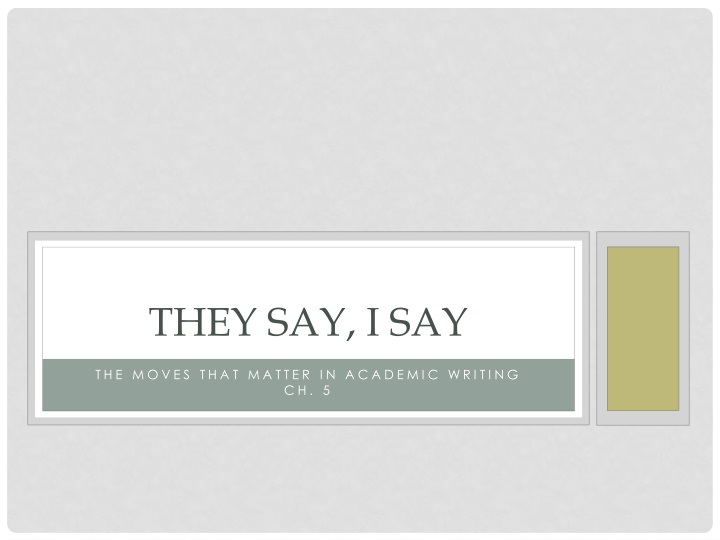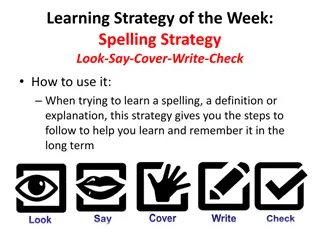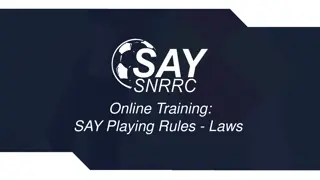
Understanding Voice Markers in Academic Writing
Learn about the importance of distinguishing between different voices in academic writing to comprehend complex texts effectively. Examples and explanations are provided to help identify signal markers and understand the author's perspective.
Download Presentation

Please find below an Image/Link to download the presentation.
The content on the website is provided AS IS for your information and personal use only. It may not be sold, licensed, or shared on other websites without obtaining consent from the author. If you encounter any issues during the download, it is possible that the publisher has removed the file from their server.
You are allowed to download the files provided on this website for personal or commercial use, subject to the condition that they are used lawfully. All files are the property of their respective owners.
The content on the website is provided AS IS for your information and personal use only. It may not be sold, licensed, or shared on other websites without obtaining consent from the author.
E N D
Presentation Transcript
THEY SAY, I SAY T H E M O V E S T H A T M A T T E R I N A C A D E M I C WR I T I N G C H . 5
CH. 5: AND YET DISTINGUISHING WHAT YOU SAY FROM WHAT THEY SAY Determine who is saying what in the texts you read This is important when reading challenging works for school. The authors mention that: when students have trouble understanding difficult texts, it is not just because the texts contain unfamiliar ideas or words, but because the texts rely on subtle clues to let readers know when a particular view should be attributed to the writer or to someone else. (68-9)
EXAMPLE OF SIGNAL MARKERS We are all middle-class, or so it would seem. Our national consciousness, as shaped in large part by the media and our political leadership, provides us with a picture of ourselves as a nation of prosperity and opportunity with an ever expanding middle-class life-style. As a result, our class differences are muted and our collective character is homogenized. Yet class divisions are real and arguably the most significant factor to determining both our very being in the world and the nature of the society we live in. - Gregory Mantsios, Rewards and Politics and Economics of Class in the U.S. Opportunities: The
EXPLANATION: The authors note that Although Mantsios makes it look easy, he is actually making several sophisticated rhetorical moves here that help him distinguish the common view he opposes from his own position (69). Look at this: the phrase or so it would seem, this demonstrates that the author does not necessarily agree with the view he is sharing Puts this opening view in quotation marks, showing that these are not his words Summarizing, he distances himself by saying that our national consciousness, as shaped in large part by the media and our political leadership he also uses phrases like our class differences, muted, our collective character, and homogenized
EXPLANATION CONTINUED Mantsios continues: He uses the word yet in the second paragraph, this indicates contradiction There is a parallelism between the first and second paragraph that sets up a contrast for the author Although he does not use the words: I argue or I say, he still identifies his view Paying attention to these voice markers can allow one to pick up
HERE IS WHAT IT LOOKS LIKE Here s Mantsio s article if you remove the voice markers We are all middle-class We are a nation of prosperity and opportunity with an ever expanding middle-class life-style Class divisions are real and arguably the most significant factor in determining both our very being in the world and the nature of the society we live in. What s the difference? Can you feel it?
TEMPLATES FOR SIGNALING WHO IS SAYING WHAT IN YOUR OWN WRITING To avoid the confusion, clearly state your points to your audience. Although X makes the best possible case for universal, government- funded health care, I am not persuaded. My view, however, contrary to what X has argued, is that . Adding to X s argument, I would point out that . According to both X and Y, . Politicians, X argues, should . Most athletes will tell you that .
BUT IVE BEEN TOLD NOT TO USE I Most of the time, yes, but there is a need at some point, in limited form to use it but to say it but get around the monotonous overuse, look at these: X is right that certain common patterns can be found in the communities. The evidence shows that . X s assertion that does not fit the facts. Anyone familiar with should agree that . But are real, and are arguably the most significant factor in .
ANOTHER TRICK FOR IDENTIFYING WHO IS SPEAKING Ways of identifying the markers without saying things like X argues can look like this: Instead of writing: Liberals believe that cultural differences needed to be represented. I have a problem with this view, however. You might write: I have a problem with what liberals call cultural differences. There is a major problem with the liberal doctrine of so-called cultural differences.
CONTINUED You can imbed your own opinion and help summarize things Instead of this: Earlier in this chapter we coined the term voice markers. We would argue that such markers are extremely important for reading comprehension. You might write: We would argue that voice markers, as we identified them earlier, are extremely important for reading comprehension. Embedding references allows one to economize thoughts without awkward interruptions.
TEMPLATES FOR EMBEDDING VOICE MARKERS X overlooks what I consider an important point about cultural differences. My own view is that what X insists is a . is in fact a I wholeheartedly endorse what X calls . These conclusions, which X discusses in the argument that , add weight to .
CH. 5- EXERCISES Study a piece of your own writing to see how many perspectives you account for and how well you distinguish your own voice from those you are summarizing. Consider the following questions: 1. 2. 3. 4. 5. 6. How many perspectives do you engage? What other perspectives might you include? How do you distinguish your views from other views you summarize? Do you use clear voice-signaling phrases? What options are available to you for clarifying who is saying what? Which of these options are best suited for this particular text? If you find that you do not include multiple views or clearly distinguish between your views and others , revise your text to do so.





![READ [PDF] Trickster Caught: An Alien Gladiator Romance (Gladiators of the Vaga](/thumb/42236/read-pdf-trickster-caught-an-alien-gladiator-romance-gladiators-of-the-vaga.jpg)
















